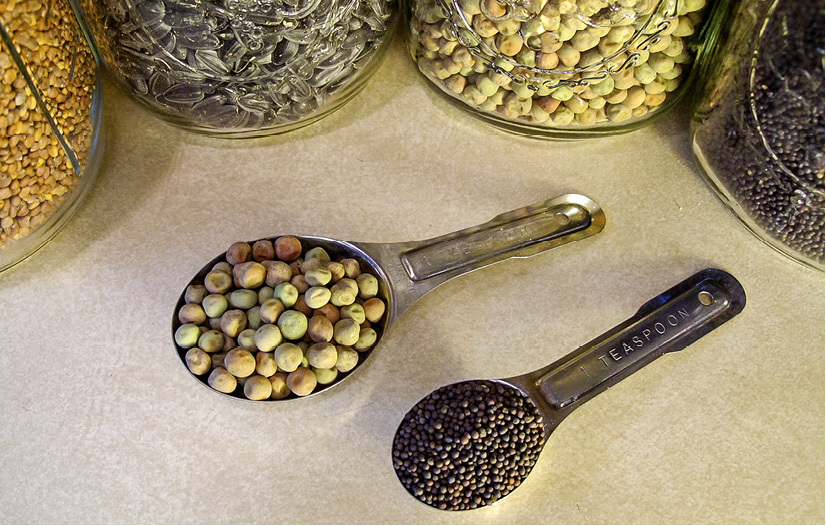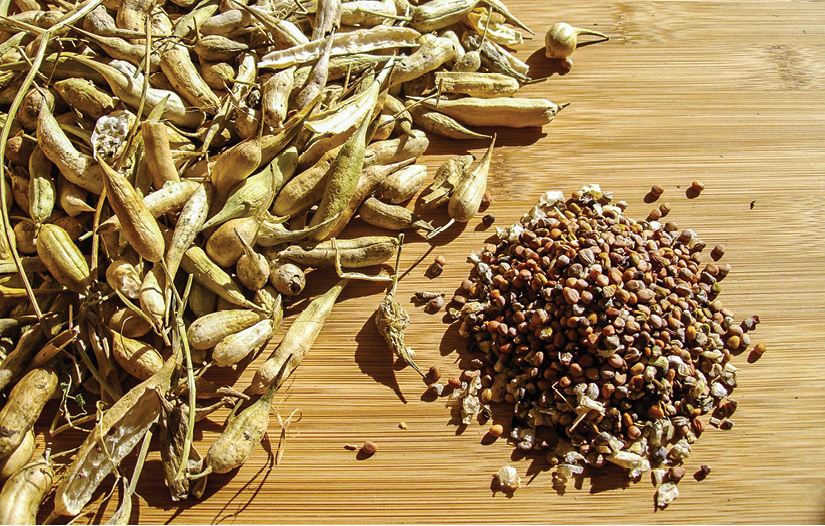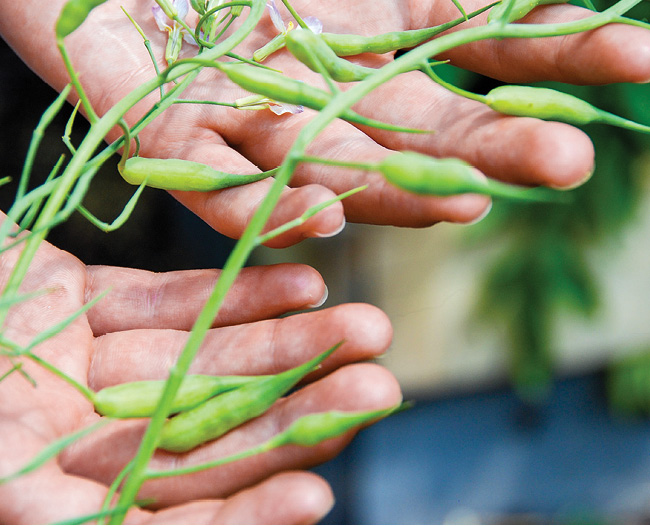


CHAPTER 8
Seeds
It’s hard for me to resist waxing poetic and musing at the miracle that is a seed. For a second each time I start the process of planting, I wonder if it will work one more time. Still, after all these years, the seeds grow like a promise kept.
During class my favorite demonstration is pulling the whole growing mass of sprouts and soil out of a tray to show students the root ball at the bottom of the “soil cake,” holding the head of greens in my hands. Growing, alive—and one more time the miracle has happened. Living food for life; it’s a poem in 3D.
Seeds Specifically for Sprouting
Seeds for sprouting are different from garden seeds in several ways. First, the sprout seeds don’t aim toward a specific result at the end of a long season. Things like color, disease resistance, number of days to harvest, size, shape, and the like are secondary issues. What matters to the indoor salad gardener considering a batch of seeds are things like the germination rate, being free of chemicals, and relatively free of weed seed.
But . . . you can forget about buying bird seed as a way to save money. When I first started experimenting I bought a bag of sunflower seeds and separated the good seed from the sticks, rocks, and broken seeds: I ended up with two piles almost the same size. These seeds are not cleaned, are frequently grown with chemicals, and may be fumigated at the warehouse. And even more ominous, some brands are genetically modified to be infertile so they will not sprout at all!
But help is at hand. Most seed catalogs will specify “seeds for shoots” or something similar. I’ve included some sources on page 179. My advice is to buy a small quantity at first, try them to see if you like them, then buy enough for your indoor salad garden.
I’ve been surprised more than once by seeds from reputable companies that I routinely plant in my outdoor garden but that don’t work for shoots. Being surprised by a pound of seed that doesn’t grow well is quite a bit different from having a 50-pound (22.7 kg) bag of seed that’s no good. So learn from my experience and try before you buy. Well, try a little before you buy a lot.
Another way to learn something about the seeds you’re buying is to ask the order taker if they’ve ever grown soil sprouts. If they act as if you’re speaking a foreign language, proceed with caution.
The Importance of Organic Seed
I’ve been an organic gardener for a long time. I first subscribed to Organic Gardening and Farming Magazine when I was seventeen years old—over 4 decades ago. The option to buy organic has grown exponentially in the past few years, and today there are companies, like my neighbors at High Mowing Organic Seeds, dedicated to offering organic seeds exclusively and to practicing organic farming methods. They’re just one of the many farms throughout the United States and Canada that are heroically holding to this standard.
In this age of genetically modified seeds, I’m gratified to see that the demand for standard and heritage varieties has had a rebirth. I hope this demand will outstrip what I consider the reckless experiments of producing genetically modified seeds. For me the last straw is the practice, in order to protect patents, of engineering seed varieties that grow into plants with seeds that are not viable. Described as a “terminator gene,” this type of genetic engineering makes me cringe. I could not buy a seed with a “death wish” as part of its internal code. It would take only one mistake by the seed companies to render a wide range of seeds unviable. Thank goodness for organic farmers who are growing viable seeds and maintaining a vital tradition.

A quart jar of larger seeds (sunflower, radish, pea, and buckwheat) is enough to plant one tray every day for 2 months and holds a 6-month supply of the smaller seeds (broccoli, canola, purple kohlrabi).
Should You Consider Commercial Untreated Seeds?
I’ve used seeds termed “commercial untreated” with good success. Even though they may be produced using conventional farming methods and chemical fertilizers, there’s typically no chemical fumigant or treatment used on the seed itself. To my mind these are OK to use for sprouts. I assume that if commercial untreated seeds are not clearly marked “organic,” then the seeds are grown with chemical fertilizer, and it is what I am getting for my sprouting seeds. You can make up your own mind on this, but I always choose organic seeds if I can.
Storing Seeds
The goal when storing seeds is to retain their viability for as long as possible. With a few exceptions seeds can be stored for about 2 to 3 years and even up to 5 years. Keeping them dry is the number one priority for retaining viability, so I store all of my seeds in glass or metal containers—canning jars are perfect for the job. A quart jar will hold about a 2-month supply of large seeds and a 6-month supply of the small seeds like broccoli or canola.
The second prerequisite for long-term storage is to keep seeds in a cool climate. Find a spot where the temperature doesn’t fluctuate but remains constant and cool. A cold cellar is a good place as long as it isn’t damp. An upstairs attic that experiences extremes of hot and cold wouldn’t work. A closet on an interior wall has a good chance of keeping a fairly constant temperature without too much fluctuation over several months.
Lastly you do not want to leave seeds in the sunlight for any time at all. Even if you just take the jars out for a few minutes while you’re planting, do not leave jars exposed to the sun.
If you have the space, you might consider keeping your seeds in a freezer. Hands down this is the best way to keep them viable and fresh for longer periods. Freezer space is scarce at my place, so I store most of my seeds in canning jars in my office on the north side of the house where there’s almost no natural light. Unlike with processed vegetables you can use glass canning jars to store seeds in a freezer because there is no water in the jar to swell and break it. The glass jar will also protect seeds from any moisture buildup inside the freezer. When you’re ready to plant let the glass and seeds come to room temperature before you open the jar. That’ll prevent condensation from forming on cold seeds and glass surfaces.

Prepare for planting with a tablespoon (14.8 ml) of large seeds for each 3-inch by 6-inch (7.6 × 15.2 cm) tray and only a teaspoon (4.9 ml) of small seeds like the canola seeds pictured here. You can keep a quart jar of each seed in a cupboard for daily plantings. I use my seed box with a 1-quart (946.4 ml) plastic container of each of the large seed types and a 1-cup (236.8 ml) plastic container of each of the small seed types.
Measures
I use two general categories for seeds: large and small.
The large seeds are things like sunflower, radish, buckwheat, and pea. Small seeds are vegetables in the broccoli family, mustard, and others similar in size—smaller than a grain of rice.
For large seeds plant 1 tablespoonful (14.8 ml) in the small 3-inch by 6-inch (7.6 × 15.2 cm) tray. For small seeds plant 1 teaspoonful (4.9 ml) in that same size tray. When I first tried small seeds like broccoli, my initial impulse was to use as much if not more seeds than with larger varieties. It became very clear very quickly that this was a mistake! I only needed one-third the amount of small seed (1 tablespoon = 3 teaspoons) because each tiny seed becomes a full-grown sprout and there are a lot more sprouts in one teaspoon’s worth of small seed.
You may have noticed that I refer to volume measurements and not weights here. That’s because a tablespoon of sunflower seeds weighs far less than a tablespoon of radish seeds, yet they require the same space when it comes to planting and growing.

Radish seeds pictured here next to their dry seed pods are very easy to grow, harvest, and store. Filling a few gallon jars with seeds for winter greens is akin to having a cold cellar full of garden produce or a woodshed full of firewood; it is a small insurance policy and a good way to keep food costs manageable.
I’ll continue discussing seed measures in this way throughout the pages to come. In chapter 15 individual seeds are listed with amounts given. Check these listings for more detailed planting information on specific seeds.
Your Seed Supply
As a rule of thumb 3 to 6 gallons (11.4–22.8 L) of each variety of large seed (like sunflower, pea, radish, and buckwheat) and 1 to 2 gallons (3.8–7.6 L) of each of the small seeds (like broccoli, purple kohlrabi, and canola) constitutes a year’s supply if you intend to plant a small tray of each variety every day, with a few large trays for special occasions. Having buckets of seed in the closet is like storing cordwood in the shed, food in the freezer, and rice in the pantry; it’s a small insurance policy and a good way to keep food costs manageable.
If you keep an outdoor garden, it’s possible to grow plants there specifically to harvest seeds for shoots, and it’s not difficult. Or should I say some of the seeds are easy to grow.
Most of the larger seeds like sunflower, pea, and even radish are not difficult for the average gardener to manage and harvest. The broccoli family needs two seasons to produce seeds, so I’ve ruled out growing my own for sprouting, at least for now.
Radishes were something new for me. The first time I tried growing them for seed, I was surprised by the shape of the pods; they looked like hot peppers. Being the curious type I nibbled on a few pods and found they were delicious when still in the immature stage. I thought I had discovered something novel when, lo and behold, I found out that radishes have been grown in India just for their pods—a variety called Rat-Tail radish—for many years.
Growing your own seeds is not only rewarding and economical, but you don’t have to worry about cross-pollination occurring because you’re only growing until you get shoots. The plant seed itself doesn’t have to be true to type, which is required for commercial growing. There isn’t room here to go into detailed techniques—that will have to be the subject of another book—but if you’re an adventurous gardener growing plants for seed is fun to try, and it’s particularly satisfying to glean a year’s supply of seeds from your own garden.

Fresh radish pods swell around the seeds as they form, sort of like a bean or pea pod. Let them dry on the vine, then harvest, and continue to dry in a covered airy spot like a porch. That is, of course, if you don’t eat them first!